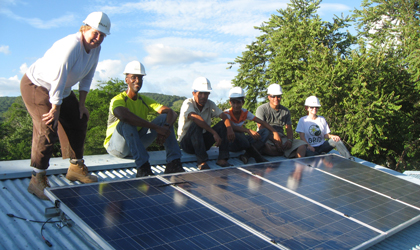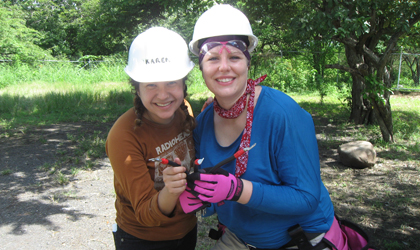In October 2014, GRID Alternatives led a trip to Nicaragua with volunteers to install two off-grid photovoltaic systems on a primary school and a health post in the community of La Trinidad, Boaco. The community of La Trinidad is located in the central region of Nicaragua in the municipality of San Lorenzo, in the department of Boaco. The community is about 7km away from the electrical grid with 198 inhabitants living in 48 houses.
 The Health Post:
The Health Post:
La Trinidad has a common well and water is brought to every house by PVC pipes, although the water is often polluted which causes diarrhea and other diseases, which affect children the most.
The health post in La Trinidad was build in 2012 and has six rooms in total: a room for general consults, a room used as a pharmacy, another room used to store files, a curing room, amedical room (where the nurse sleeps) and a bathroom.
There is an official nurse named Tanyusca, who lives at the Heath Post and attends to the people in the community from Monday to Thursday. She studies on Saturday so every Friday she leaves La Trinidad to be on time for classes the next day. She graduated as a nurse four years ago and she received a scholarship to study Public Health at college because she was a good student.
 MINSA (Ministry of Health) pays for Tanyusca´s salary and also provides medication. Tanyusca opens at 6AM and closes at 5:30PM to have time to attend between 40 to 50 patients from La Trinidad every week, from 11 communities that do not have a health post where they live.
MINSA (Ministry of Health) pays for Tanyusca´s salary and also provides medication. Tanyusca opens at 6AM and closes at 5:30PM to have time to attend between 40 to 50 patients from La Trinidad every week, from 11 communities that do not have a health post where they live.
The nurse also makes house by house visits, to attend patients with special needs or guaranty vaccination to all children from all over the communities around. Vaccines are kept in two small coolers at the health post. Tanyusca brings enough ice to keep them cool every Monday If she feels that she is running out of ice she goes back to the closest big town or sends someone to bring ice so the vaccines are kept at the right temperature.
There are some people with diabetes that need insulin every day, and because there is no refrigeration system these patients need to travel around 20km ones or twice a week to get their medication. GRID Alternatives volunteers repaired a solar system on the health post and installed a solar-powered DC refrigerator.
 The School:
The School:
The La Trinidad elementary school was built in 2006 as a donation of the Japanese government. It has two classrooms. The small classroom is used for kindergarten and the bigger classroom is used for first through sixth grade students who all attend class at the same time. Maria Jose Luna is the kindergarten teacher and Edith Chavez the first through sixth grade teacher.
There are 12 children that attend to kindergarten and 33 attend first through sixth grade. The school is in very well maintained and is in very good condition. When students finish primary school they have to travel to the nearest town for high school education since there is no high school in La Trinidad.
GRID Alternatives volunteers installed a 1.38kW system on the elementary school, bringing lights and AC power that the teacher and students can use to improve education in their community.
 Tourism and Cultural Activities:
Tourism and Cultural Activities:
Volunteers visited the colonial city of Granada, the first city in the New World, established in 1524 and well known for its brightly painted buildings and vibrant international culture. Volunteers also stayed at one of the country's most beautiful sustainable coffee farm's in Matagalpa called Selva Negra.
Click here to view photos from the trip.

